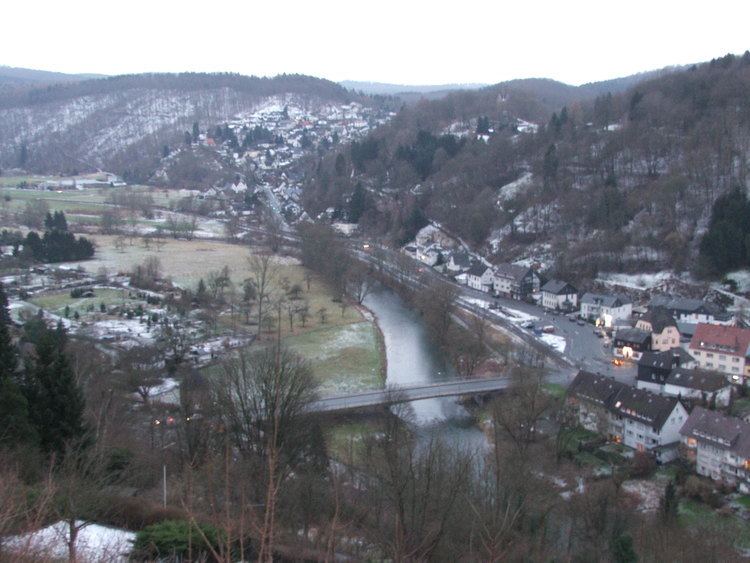Admin. region Arnsberg Time zone CET/CEST (UTC+1/+2) Population 74,617 (30 Jun 2010) Number of airports 1 | District Hochsauerland Area 193.4 km² Local time Wednesday 10:34 PM | |
 | ||
Postal codes 59755, 59757, 59759, 59821, 59823 Weather 5°C, Wind S at 14 km/h, 87% Humidity Points of interest Ruhr, Wildwald Voßwinkel, Herdringen Castle, Nass Arnsberg, Schloss Arnsberg | ||
Places to see in arnsberg germany
Arnsberg ( [ˈarnsbɛrk]) is a town in the Hochsauerland district, in North Rhine-Westphalia, Germany. It is the location of the Regierungsbezirk Arnsberg's administration and one of the three local administration offices of the Hochsauerlandkreis.
Contents
- Places to see in arnsberg germany
- Map of Arnsberg Germany
- Germany winterberg arnsberg by train sauerland hd
- Location
- Neighbouring municipalities
- Subdivisions
- History
- Religion
- Arts and culture
- City arms
- Mayors
- Town twinning
- Notable people
- People related to Arnsberg
- References
Map of Arnsberg, Germany
Germany winterberg arnsberg by train sauerland hd
Location
Arnsberg is located in the north-east of the Sauerland in the Ruhr river valley. The river Ruhr meanders around the south of the old town of Arnsberg. The town is nearly completely encircled by forest, and the nature parkArnsberger Wald lies to the north".
Arnsberg is connected by Federal Motorway 46 to Brilon in the east and (using the Federal Motorway 445) Werl in the west.
The municipal territory spans a distance of up to 13 kilometres (8.1 mi) from the southern to the northern limits.
Neighbouring municipalities
Subdivisions
After the local government reforms of 1975 Arnsberg consists of 15 boroughs (Ortsteile):
History
Arnsberg was first mentioned in 789 in the Carolingian records (Urbar) as belonging to the abbey of Werden. The town was built by the counts of Werl in the 11th century. They built a castle there whose remains can still be visited and are occasionally used for public celebrations. It was destroyed in the Seven Years' War in 1769.
In the 12th century, old Arnsberg became the seat of Westphalian jurisdiction (whose coat of arms is still used today by the Hochsauerlandkreis). Later, the city lost its independence and was subject to the Archbishops of Colognea. In 1816, it came under Prussian rule and was made a local administrative centre.
The current city of Arnsberg was created in 1975 by merging 14 cities and municipalities into one city. Old Arnsberg itself and Neheim-Hüsten are the two urban parts, while the other parts are very rural. Neheim and Hüsten were merged in 1941.
In the Second World War, Arnsberg first suffered widespread destruction and catastrophic loss of lives when RAF Lancasters breached the dam of the Möhne Reservoir in the night from 16 to 17 May 1943 (Operation Chastise). The nearby Abbey Himmelpforten was completely washed away.
Later, dozens of Arnsberg citizens were killed in several British air raids aimed at destroying the railway viaduct. The targets were finally destroyed on 19 March 1945 using a Grand Slam bomb.
Religion
Arnsberg's population is mostly Roman Catholic. Catholic churches include the "Probsteikirche" or the "Heilig-Kreuz Kirche"; the "Auferstehungskirche" is a Protestant church. There is also a New Apostolic congregation. The cemeteries are mostly Catholic but there is also a Jewish cemetery.
Arts and culture
The Kunstverein Arnsberg operates in Arnsberg. Founded in 1987 and devoted to contemporary art, Kunstverein Arnsberg has presented solo exhibitions by artists including George Baselitz, Thomas Ruff, Karin Sander, Dan Perjovschi, Boris Mikhailov, Gregor Schneider, Erwin Wurm, the Turner Prize winner Susan Philipsz and the Marcel Duchamp Prize winner Laurent Grasso.
City arms
The arms of the city depict a white eagle on a blue field. Earlier it was a white eagle on a red field, introduced in 1278 and as used by the counts of Arnsberg . In the 17th century the red was changed to blue, reflecting the Bavarian blue of the House of Wittelsbach.
Mayors
Mayors of the new town Arnsberg
Town twinning
Arnsberg is twinned with:
